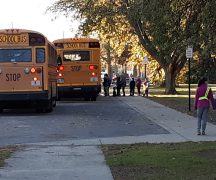By JAN LARSON McLAUGHLIN
BG Independent News
Public school officials from across the region made a united plea to State Sen. Theresa Gavarone, Friday, to stop the state’s gutting of public education with the EdChoice program.
Gavarone, R-Bowling Green, met with school board members, superintendents and treasurers from districts facing the loss of students and funding to private schools.
“I think that took a whole lot of guts,” Bowling Green Board of Education President Ginny Stewart said. “I think her intentions were very good.”
School buildings can be demoted to EdChoice status for a host of reasons. The designation means that any student at an EdChoice school can get state scholarship money to go to a private school – until they graduate high school.
In Bowling Green, Crim Elementary recently joined Kenwood Elementary in the distinction. Others in Wood County are Lake high school and middle school, and Northwood elementary and high school.
The number of EdChoice schools in Ohio nearly doubled last year – to more than 1,200. The Ohio School Board Association has predicted that 2,000 schools will drop into the category by next year.
Gavarone said she wanted to hear from schools affected in her district.
“There is a concern with the number of schools that have been added,” she said Saturday. “I wanted to make sure I heard from everyone.”
Gavarone assured school officials that changes are being discussed by Gov. Mike DeWine, the State Senate and the House of Representatives.
“There are a lot of people working on this right now,” she said. “I do believe we will be seeing some legislation coming in the near future.”
But time is ticking away toward the Feb. 1 deadline when applications to private schools become available for students in this year’s round of EdChoice schools. So the immediate goal of some of the school officials Friday was to get a moratorium on the EdChoice scholarships.
The private schools taking in the students get “scholarships” of $4,650 a year for K-8 grades, and $6,000 a year for 9-12 grades.
Meanwhile, for each child leaving Kenwood Elementary, the school district loses $2,213 a year from the state, plus has to pay up to an additional $2,437 to the private school. That adds up to a potential total loss to the district of $4,650 per student.
The reason Bowling Green City Schools receives so much less than the private schools is because of the district’s “perceived wealth,” Scruci has said.
Even if Crim and Kenwood shed the EdChoice designation in a few years, the expenses could linger. The state program allows parents of kindergartners to take them out of the public school and place them in private facilities all the way through graduation.
The bigger goal sought by school officials on Friday was to look beyond a moratorium to examine the overall EdChoice program that is causing students to flee to private and parochial schools, and siphoning money from public schools to pay for their scholarships.
Attending Friday’s meeting in Port Clinton were Bowling Green Superintendent Francis Scruci, board members Ginny Stewart, Jill Carr and Norm Geer, and Angie Schaal, the district’s executive director of teaching and learning.
“People spoke their minds on how EdChoice is impacting the schools and their students,” Carr said on Saturday. “You can tell there are really strong feelings about what EdChoice is doing.”
They were joined by school officials from throughout the region.
“We are all united under this opposition to EdChoice,” Scruci said of the program that is affecting urban and rural, rich and poor schools. “We’re all facing different challenges, but this EdChoice opposition has united all of us. It’s affecting every type of school district – that tells you there’s an issue.”
Some very wealthy districts, with very high test scores, have been demoted through EdChoice. Lake Schools has gone from a district rated as “excellent with distinction” to failing under EdChoice. And Bowling Green received three consecutive years of “Momentum Awards” from the state – then got hit with the EdChoice demotion.
“It makes you feel like you aren’t in this alone,” Stewart said. “There is such a disconnect.”
The EdChoice designations sink teacher and student morale, Stewart said. And the program drains needed money from public schools.
“They expect us to fix what they are telling us is broken, without giving us the money to fix it,” she said.
The practice is found troubling to many facing the demotion.
First, the scholarships aren’t given to the students who struggled with the state testing. Instead, the top students may choose to leave for private schools – making it even harder for the EdChoice school to reach the grades it needs to shed the designation.
One superintendent at Friday’s meeting said the EdChoice ranking has led to the higher performing students leaving – putting the district in a worse situation.
Second, the publicly funded scholarships are paid to private and parochial schools – which don’t undergo the rigorous state testing required of public schools. So transferring to private schools may or may not benefit the students.
“Private and charter schools don’t have the testing requirements that the public schools do,” Carr said.
“How does this program assess accountability from parochial and private schools,when we have to answer to such higher standards,” Stewart said.
And third, for every student who leaves an EdChoice school, the district loses state funding. So who suffers in the long run when a district has less to spend on education?
Some of the school officials on Friday expressed concerns about the state draining public school funding in order to support charter or parochial schools.
That trend is very troubling, Carr said.
“Public education is a cornerstone of our democracy – I really feel that way,” she said.
Gavarone said she does not believe the EdChoice program is rooted in favoritism to private schools – even if that may have been the result.
“I really think the focus is on kids,” she said. “It’s important we find a solution that’s going to best serve our kids.”
Gavarone, herself, is a proponent of public schools – with her three children graduating from Bowling Green High School.
“They’ve all gone on and done well,” she said. “I feel all my kids left Bowling Green Schools very well prepared for their next steps.”
Scruci has stressed that the district is not shirking responsibility – but is questioning the metric used to designate Ed Choice schools. In Bowling Green, the ranking was based on K-3 literacy test results from 2013-14, 2017-18 and 2018-19.
Research shows that students from lower economic status often come to school less prepared. Bowling Green is judged on the same scale as Perrysburg – though 80 to 90 percent of Perrysburg kindergartners come into school with acceptable skill levels compared to 50 percent in Bowling Green. So Bowling Green students have much further to go to reach that third grade standard. Teachers spend a great deal of time helping students catch up.
The even bigger issue to be considered is the overall state report card program, Gavarone said on Saturday.
“I don’t think the school report cards reflect what’s going on in the classrooms,” she said.
While Gavarone believes the state needs to ensure students are getting good educations, she doesn’t think the current testing system is a valid measurement.
“I think we do need to look at how schools are assessed,” she said.
Scruci praised Gavarone for holding the meeting with school leaders.
“She does listen. She takes all the information her constituents share, and I know she appreciates public education,” he said.





